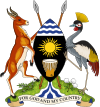LGBT history in Uganda
Uganda has a long and, until relatively recently, quite permissive LGBT history. During precolonial times, the “mudoko dako,” or effeminate males among the Langi of northern Uganda were treated as women and could marry men. Religious roles for cross-dressing men (homosexual priests) were historically found among the Bunyoro people. The Teso people also acknowledged a category of men who dressed as women. It is to be noted however, that a man dressing as a woman has nothing to do with his sexual orientation and vice versa [1]
It is alleged that Kabaka Mwanga II, who ruled in the latter half of the 19th century, was bisexual. However there is no historical documentation of this.[2] Homosexuality in Uganda was criminalized in 1902.[3]
In February 2014, president Yoweri Museveni signed a new law, the Uganda Anti-Homosexuality Act, which provided for tougher penalties for gay people including criminalizing people who did not report them.[4] The new law also covered lesbians for the first time.[4] However, on 1 August 2014, the Constitutional Court of Uganda ruled the new law invalid.[5][6][7]
References[]
- ^ Anthony Appiah and Henry Louis Gates, Encyclopedia of Africa, Volume 2 OUP, USA, 2010
- ^ "OPINION: Homosexuality is not un-African".
- ^ "Where is it illegal to be gay?". BBC News. 10 February 2014. Retrieved 23 February 2014.
- ^ a b "Ugandan President Yoweri Museveni signs anti-gay bill". BBC News. 24 February 2014. Retrieved 24 February 2014.
- ^ "Uganda anti-gay law challenged in court". The Guardian. AFP. 31 July 2014. Retrieved 1 August 2014.
- ^ "Uganda court annuls anti-gay law". BBC News. 1 August 2014. Retrieved 1 August 2014.
- ^ "Uganda constitutional court annuls new anti-gay law". Times LIVE. AFP. 1 August 2014. Retrieved 1 August 2014.
- History of Uganda
- LGBT history by country
- LGBT in Uganda
- LGBT law stubs
- Uganda stubs
